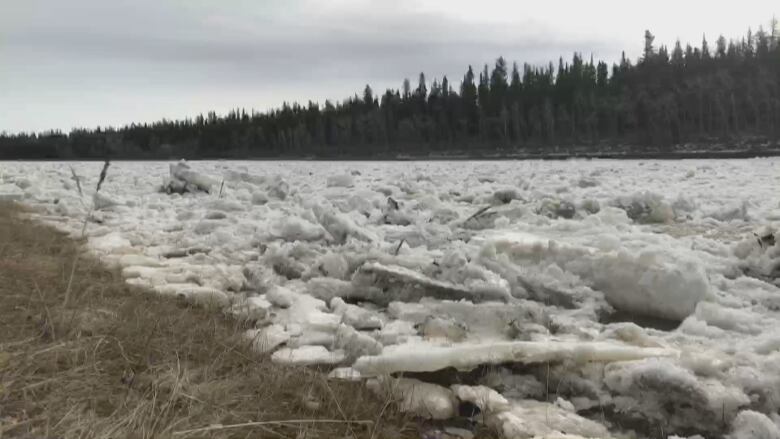Spring breakup causes fish to fly on Hay River
'Wherever there was a crack in the ice, fish came flying right out of there,' says Doug Lamalice

As the ice begins to crack and shift on waterways across the Northwest Territories, the breakup has come to an end for the Hay River — but not before causing an unusual sight for one local resident.
Doug Lamalice lives on the K'atl'odeeche reserve and said as the water pushed against the ice, he saw fish shoot through cracks over half a metre into the air.
"They blew right out of the ice and landed on top of the ice. So wherever there was a crack in the ice, fish came flying right out of there," said Lamalice.
The 56-year-old said it was the first time he's ever seen anything like it, with at least 20 fish and many more small suckers stranded on the ice. He said it made a great feast for local birds who swooped down to snatch the fish up.
"They were cleaning up those fish like crazy and there were tons of them," he said.
Hay River breakup had 'fairly good year'
According to Ross Potter, director of Protective Services for the Town of Hay River who monitored the breakup over the weekend, it was finished by Sunday night after 9:00 p.m.
The first break through was on May 4 on the river's west channel and two days later ice went out in the centre channel, Potter said.
"All of the water was flowing to the west, which is what we like to see," he said.

If the breakup had flowed toward the east channel, it could have posed a risk to nearby residents. In previous years it has jammed the waterway and caused flooding, although the last time homes had to be evacuated was in 2009.
Potter said this year's breakup was comparable to the last three years. Because the water table was really low in the fall, he expected it would also be low during the breakup this spring.
"This year was a fairly good year. We did see a little bit of some levels that are a little bit high but they managed to deal with themselves through the west channel," he said.
Monitoring operations are now being shut down, Potter said, but they will still be keeping an eye on the lake shore.
He added that monitoring the breakup wasn't a one man job and he's thankful for the help of community volunteers.
- MORE NORTH NEWS | N.W.T.'s 2018 forest fire season could look similar to last year — 'fairly vigorous' late season
- MORE NORTH NEWS | Oceanic warming threatens polar wildlife with extinction
Former chief says there's changes over years
As ice from the Hay River moves along the riverbank toward Great Slave Lake, it sets up breakup along the Mackenzie River.
Joachim Bonnetrouge, former chief of the Deh Gah Gotie Dene in Fort Providence, said he's seen changes with the Mackenzie breakup over the years.
The freeze up in the fall, early winter is really different.- Joachim Bonnetrouge, former chief
When he was younger, he said the ice began going out around May 25 and the winters seemed longer and colder. He also said he remembers the ice being thicker.
"For me that's the big change, the elders have been telling us whenever we go anywhere in the winter time and the fall time to watch because the freeze up in the fall, early winter is really different," he said.
Bonnetrouge also said he's noticed changes in migratory bird patterns. This year in particular, he said harvesters have told him because the cold spell lasted longer than usual, birds that normally stop in Fort Providence headed directly north.
With files from Lawrence Nayally, Marc Winkler